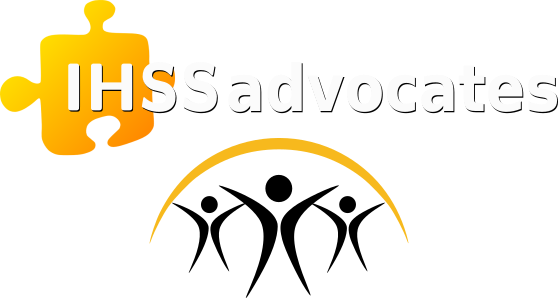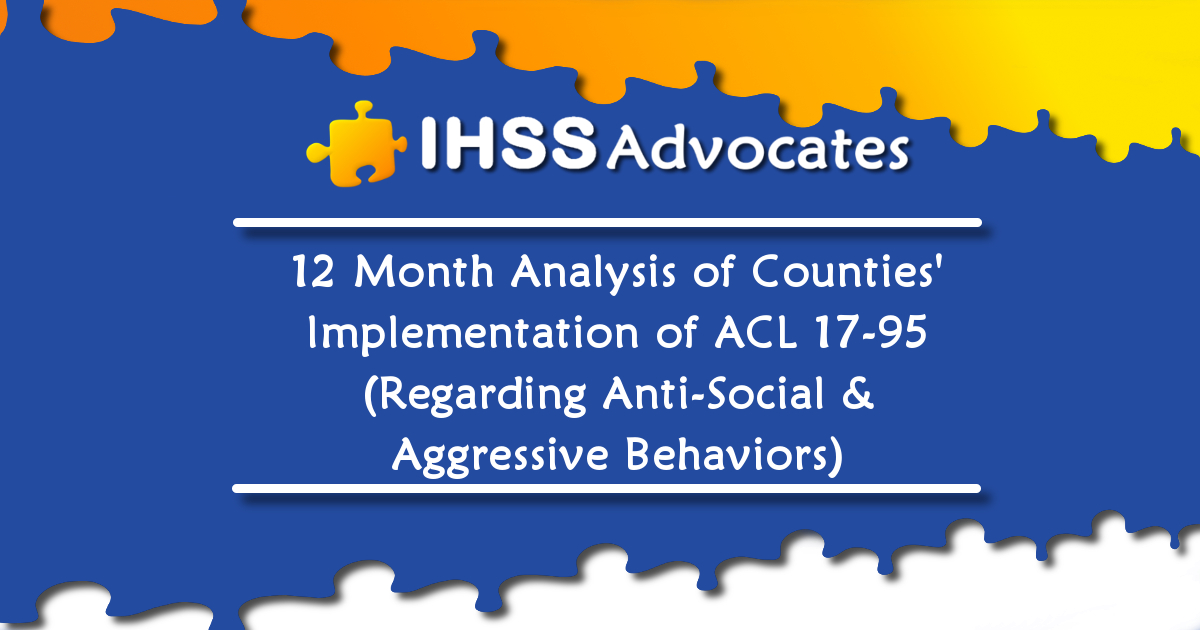12-Month Analysis of Counties’ Implementation of CDSS All County Letter 17-95 (Regarding Anti-Social and Aggressive Behaviors)
Analysis written by IHSS Advocate, David Wolff
CDSS All County Letter (“ACL”) 17-95 was released by the State on 09/12/17 and was intended to clarify a number of areas, including the following.
- Protective Supervision proration
- environmental modifications
- fall-risk
- anti-social behavior
- aggressive behavior
With a focus on ACL 17-95 Anti-Social and Aggressive Behavior guidelines, this analysis encompasses, breaks down and summarizes this author’s/advocate’s direct observations of the IHSS review process within the last 12 months.
The following 3 paragraphs have been “cut and pasted” from pages 6 and 7 of ACL 17-95 and contain CDSS’ new policies in connection with the following.
- anti-social behavior
- aggressive behavior
- combative behavior
- deliberate behavior
- Protective Supervision eligibility
*Note: Bold & italicized words below are the author’s.
Anti-Social and Aggressive Behaviors and PS-Eligibility
Assessing PS-eligibility, due to a recipient’s (minor or adult) combative behavior, shall be evaluated based upon the willfulness of that behavior. As with all services, the recipient’s age and specific behavior shall be considered.
When assessing for PS-eligibility, a recipient must have a mental impairment/illness and determined to be nonself-directing, due to the mental impairment/illness. The recipient would be considered nonself-directing if he/she is unable to assess danger and the risk of self-harm. A recipient who meets these criteria and displays self destructive behaviors, such as head-banging, as a manifestation of the mental impairment/illness, may be eligible for PS. However, a recipient who has a mental impairment/illness and is determined to be nonself-directing, due to the mental impairment/illness, but exhibits anti-social or aggressive behavior (e. g. pulling hair, scratching, hitting) directed to harm another individual, would be ineligible for PS. [MPP Section 30-757.172 (d)].
Additionally, a recipient who displays intentional self-destructive behavior, with knowledge that the activity may cause self-harm, would not be PS-eligible. [MPP Section 30-757.172(e).] This type of behavior may include tantrums or head-banging as a way to achieve a desired result. In this case, the recipient would be considered self-directing, as there is knowledge that the activity may cause self-harm; therefore, he/she would be ineligible for PS.
As indicated above, and with respect to head-banging and tantruming, there are 2 components to denying an individual Protective Supervision:
- An individual must be deemed to be self-directing (ie., he/she must be aware of potential self-harm)
- The individual’s self-directed and intentional head banging/tantruming is determined to be an attempt at achieving a desired result (therefore this behavior would be labelled as combative/aggressive/anti-social (MPP § 30-757.172(d) and/or (e)). Hence, the individual would be disqualified from receiving Protective Supervision.
In light of the fact that ACL 17-95 was implemented twelve (12) months ago, the author has had ample time to digest and analyze precisely how this policy is being carried out by both State and county officials.
First, the author has encountered the following seemingly automatic (and oddly consistent) interpretation among social workers, Appeal Representatives and ALJ’s:
Tantruming and head banging are now routinely classified as aggression (MPP § 30-757.172(d)), antisocial behavior (MPP § 30-757.172(d)) or deliberate attempts at self-harm (MPP § 30-757.172(e)).
And while this trend is now “the norm,” the author has yet to witness any serious examination or discussion of whether an individual is truly aware of potential self-harm (i.e., it seems that, “all you need is the excluded behavior”). Additionally, this (assumed) “link” between “awareness of potential self-harm” and attempts at “achieving a desired result” appears “somewhat dubious,” at best.
Additionally, within the last 12 months, one particular exchange inevitably occurs at virtually every IHSS in-home assessment and it goes something like the following:
Claimant: “Johnny tantrums and elopes and bites himself.”
Social Worker: “Really? Do you know why?
Claimant: “Sometimes I do, sometimes I don’t. Sometimes he wants food, or he wants a trip to Chuck E. Cheese or he doesn’t want to help clean-up.”
Social Worker: “A trigger!! Now we know why Johnny tantrums, runs off and bites himself!! Now we understand !! Johnny is self-directing!!!”
Clearly, determining whether an individual is non-self-directing has very little to do with the cause (or trigger) of the behavior and everything to do with an individual’s (reasonable or unreasonable) reaction to the trigger. When 7-year old Johnny cries after being told, “No, we’re not going to Chuck E. Cheese today,” this could be viewed as self-directed behavior. There is no engagement in potentially dangerous behavior(s). But when Johnny’s told “No Chuck E. Cheese today,” and he bangs his head, runs out the door or bites himself, then his actions are potentially non self-directed. If the county claims that Johnny’s head banging/tantruming (caused by “no Chuck E. Cheese visit”) is an example of self-directed behavior, the county must demonstrate that Johnny is aware that his head banging/tantruming is potentially dangerous.
Simply put:
It’s the behavior, NOT the trigger.
And just because a social worker (or parent) thinks they know the reason(s) for bad behavior, it doesn’t mean a child is self-directing (or, that a developmentally disabled child suddenly becomes aware of potential self-harm, commensurate with neurotypical cohorts). For some odd reason, the State and counties are focusing almost exclusively on triggers and not on the actual behaviors (or reactions) themselves. In other words, State and county officials appear to be “going backwards” by deeming individuals self-directing simply based on the identification of a trigger (or possible trigger). Similarly, it appears that IHSS is simply “skipping” the non-self directing piece to ACL 17-95’s anti-social/aggressive behavior policy.
Finally, when Protective Supervision is denied based on the ACL 17-95 “argument,” State and county officials must clear two rather high hurdles. Pursuant to WIC § 16519.6(l), MPP § 22-073.36 and CDSS ACIN I-12-09, counties have the burden of proving, by a preponderance of evidence (Evidence Code § 115), that:
- An individual is aware that his/her tantruming and/or head banging may cause self-harm; and
- An individual’s tantruming and/or head banging are self-directed, intentional acts 100% of the time.
Accordingly, ACL 15-25, page 4, paragraph 6 states:
If a recipient only displays needs or behaviors excluded under MPP §30-757.172, they are not eligible for Protective Supervision. If a recipient displays self-injurious behavior that would qualify for Protective Supervision, but also displays excluded behavior(s) based on MPP §30-757.172, they may still be eligible for Protective Supervision for the non-excluded behaviors.
If you need any assistance, you are welcome to join our support group at: IHSS Advocacy Group

